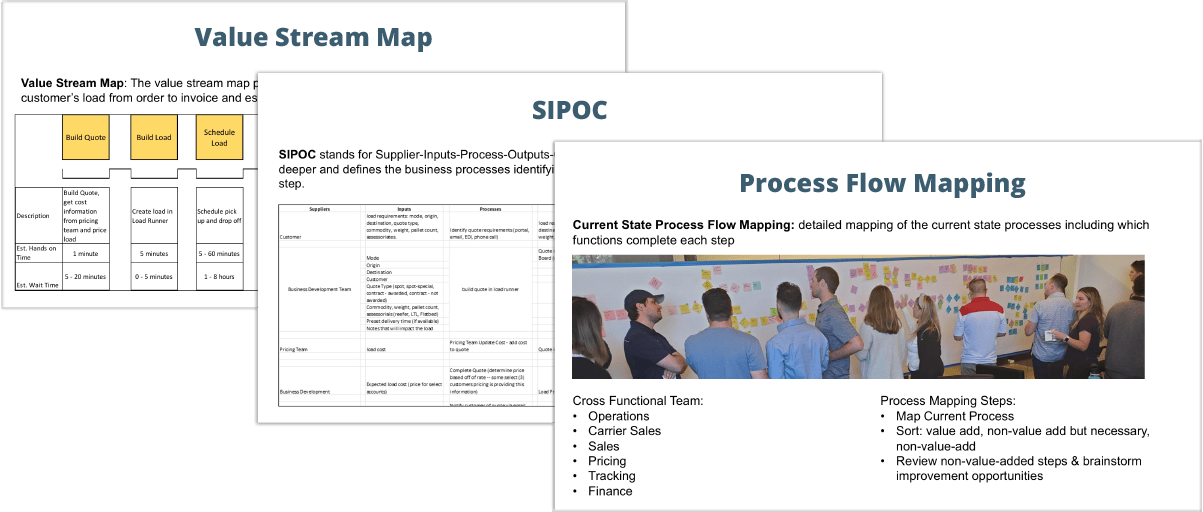Lean Process Improvement
Lean is a culture of continuous improvement with a series of methods to identify and eliminate non-value-added work (a.k.a. waste) in processes. The goal is to make your processes more productive and respond faster to customers. Most often identified with manufacturing (Lean Manufacturing), it has been widely adopted over the last 20 years in distribution/warehousing and healthcare/hospitals. However, Lean works for all processes. It helps you create visibility of waste and is universally applicable to drive efficiency in any business process. It works whether you are a non-profit, professional services firm, repair company, retailer/etailer, construction company, transportation firm or are in the traditional Lean industries: manufacturing, distribution or healthcare. There is no methodology that has been found to be more successful than Lean at providing a foundation for operational excellence.
Lean Process Improvement (LPI) can be done for large and comprehensive business processes, such as order-to-delivery for a supply chain, or more focused processes such as hiring and onboarding. It can be implemented as a Kaizen Event for the focused process or as a project for comprehensive business processes. Many companies use Lean consultants or internal Lean Champions to facilitate teams of people working directly in the process.
Implementing comes primarily from three Lean Six Sigma methodologies: Value Stream Mapping (VSM), Supplier-Input-Process-Output-Customer (SIPOC) and Process Flow Mapping (PFM).

Value Stream Mapping or VSM is a way to see the current state of high level core processes, visually and quantitatively. Pictograms are used to represent different functions and movements. Most importantly the map quantifies potential waste. VSM is a great way to begin your Lean journey by identifying areas for improvement and providing data on the potential benefit.
SIPOC (Supplier-Input-Process-Output-Customer) is a visual tool for documenting the suppliers and inputs that processes transform into specific outputs for each customer. Using SIPOC in conjunction with VSM provides a powerful baseline of a business from beginning to end.
The final methodology used in LPI is Process Flow Mapping. The Value Stream Map and SIPOC are strong inputs to a comprehensive process flow map. The process flow map is used to identify, document and remove non-value added steps. Process flow mapping starts by mapping the current state. The team will then sort each step into two categories: value-added and non-value-added. Subject matter experts (SMEs) along with the Lean Process Improvement Team will brainstorm ways to eliminate or streamline the non-value-added steps. The final step is creating the future state, which is the current state with non-value-added steps removed. This process differentiates Lean Process Improvement from Business Process Reengineering. Instead of dreaming new ways to design a process, Lean simply seeks to remove and streamline non-value-added steps.
History of Lean Six Sigma
The methodology for Lean Process Improvement has built up over decades starting with the quality revolution that began after WW2 to Lean and Six Sigma, and includes:
- Quality revolution in Japan driven by Dr. Juran and Dr. Deming, circa 1950
- Toyota develops Toyota Production System (TPS), 1950’s to 1970’s
- Six Sigma approach developed at Motorola, 1980’s
- Business Process Reengineering the Corporation or BPM by Hammer and Champy, 1990’s
- Jack Welch of GE adopts Six Sigma, late 1990’s
- Rapid growth of Lean & Six Sigma in manufacturing, 1990’s through 2000’s
- Growth of Lean & Six Sigma in service, 2000 – today
Getting Started with a Lean Process Improvement Assessment
To help you get started on your implementation, Supply Velocity’s Lean consultants will conduct a Lean Assessment, evaluating your business based on Lean best practices. All of our consulting services (including lean consulting and supply chain consulting) use Lean and Six Sigma tools and techniques to achieve fast and sustainable results. In addition, every Supply Velocity business consultant is experienced in facilitating cross-functional teams of subject matter experts and managers to make sure the team does not get bogged down in conflicting ideas and objectives.
Lean process problem areas we identify and address often include:
- Long order lead times and poor on-time delivery
- Complex processes with many steps and multiple hand offs, that include non-value-added activities such as waiting, duplication and rework
- Highly reactive organizational cultures
- Complex and or misaligned organizational structures with confusing roles and responsibilities
- Lack of standardization
- Inconsistent product or service quality
- Poor customer service (difficult to do business with)
- Disconnected internal and external communications
After Lean Process Improvement is implemented, you must sustain the gains. This is key to true Lean transformation and a focus of all of our Lean consulting services. Sustainment requires measuring the performance of processes through Balanced Performance Scorecards and monthly scorecard reviews. Streamlined processes combined with a monthly/weekly cadence of performance measurement review and action plans creates a virtuous cycle of continuous improvement.
Lean Process Improvement can help your company meet internal goals and metrics including:
- Greater capacity and throughput
- Improved labor productivity
- Less rework and reduced scrap
Equally important, they can help your company meet external customer requirements such as:
- On-time delivery
- Improved quality
- Easy to do business with
More on Lean Consulting
Ask us your Lean, Six Sigma, or Supply Chain question.
We’re the experts! We’ll get back within 48 hrs. with a valuable response.
"*" indicates required fields
